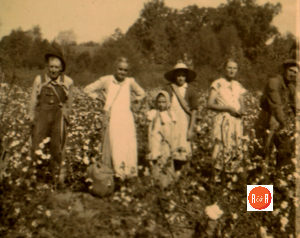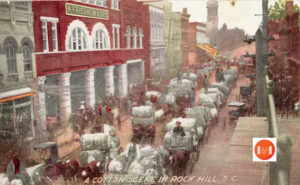An appreciation for Piedmont life and culture….one not shared by everyone!
Ben Robertson in his classic, Red Hills and Cotton, speaks with the voice of the genuine Up-Country South Carolinian concerning names: “We gave our places Northern names from

A sharecropper’s family at work in the red hills and fields of S.C.
Pennsylvania, where so many South Carolinians originally settled and Biblical names—Chesterfield, York, Ebenezer, Mount Zion, Bethany, Pisgah; and we called places for whimsies that struck our fancy—Nine Times, Lickety Split Creek, Honea Path, Due West….. We understand in our country why Walt Whitman liked to sing the names of American rivers, why for apparently no reason at all he listed them one after another. We know what swept Thomas Wolfe when he wrote of the golden Catawba, of the Swannanoa, of the Little Tennessee—it was lightning from his heart.”
Yes, I too love reading about names such as Lickety Split Creek, Bear Bay or Coon Hill and wondering just how they received their simple names, one that stuck. Would it not be better served to have named items after the adjacent landowner or tributary of a larger stream? It seems names in the 19th century were indeed whimsical and far more interesting than what we derive today. Just how many people need to live in an “Estates” subdivision? It sort of reminds me of trying to make a commercial metal building into a classic Greek Revival style, false columns and all, when it really should be left as a simple box. If you are going to do it – do it with character! Recently, a place of historic importance described as “the Devil’s Backbone” has come to light in my own family research, an important and locally recognized name, in the 19th century but no more! We can’t find it on any map, index, scrap of paper, etc. and I need to so badly locate it!
Names do made a difference and for that reason, Roots and Recall has painstakingly indexed thousands of sites and names from hundreds of maps across S.C. In this manner, R&R members-users can hopefully promptly find the location of their ancestor’s cabin or farm, store or church. Enjoy taking a look at these three examples:
- Tirzah in York County, S.C.
- Clowney’s Gin in Fairfield Co., S.C.
- Gen. William’s Cotton Mill in Darlington Co., S.C.
*** The Tirzah map is from Walker’s 1910 Postal Map, Clowey’s Gin from a 1908 School District Map and William’s Cotton Mill was found on one of Mill’s Atlas Maps.

Showing off the cotton crop in Rock Hill, S.C.
Maps are an invaluable tool in linking data to specific locals but they do much more, they somehow validate, “we were here, at this specific spot.” For this reason, Ben Robertson’s statement is very appropriate to our fully appreciating the culture of the region. So, R&R’s goal of connecting users to a specific homeplaces and locations is alive and well, maps are so relevant to fulfilling this goal and enjoying the heritage of our Red Hills and Cotton culture. Do you know of old postal maps you might have that R&R could digitize?
R&R Notes: We heard from a number of member-users who felt the images dealing with faux painted surfaces were not displayed large enough, they would like to have had enlargeable images. Yes, that would be nice but with over 300,000 images already on R&R, it is imperative that the website not expand our digital footprint. Perhaps one day that will be feasible! And we must thank Charles Payne, a new R&R photographer – member, one who has already contributed a number of beautiful photographs for display at Musgrove Mill and other R&R’s pages.
Someone has been listening, external links to R&R have substantially increased! Have you asked your local library and museum to link their websites to Roots and Recall – it really makes a difference!
From the Porch – Blog @ RootsandRecall.com – 5.18.17
